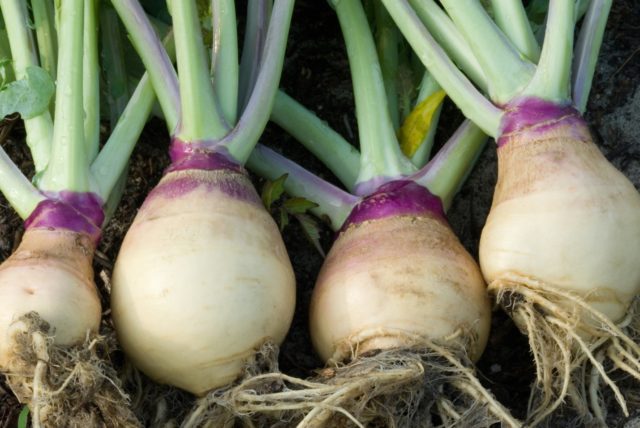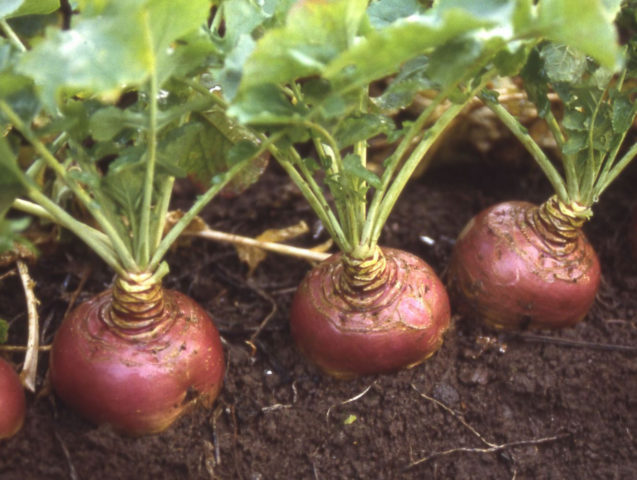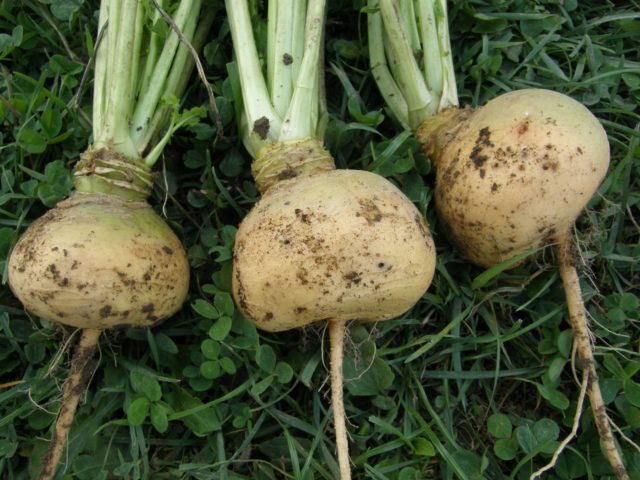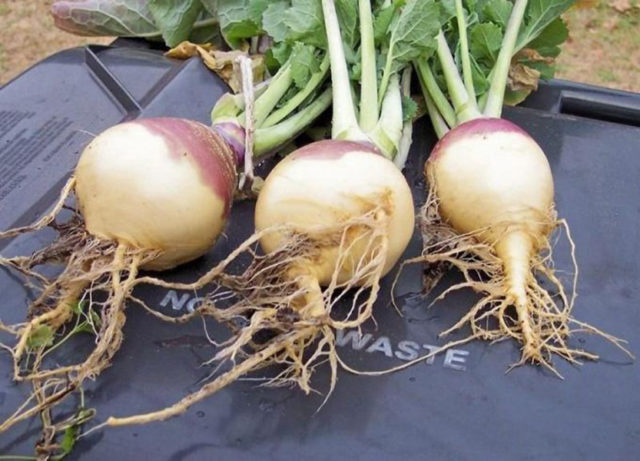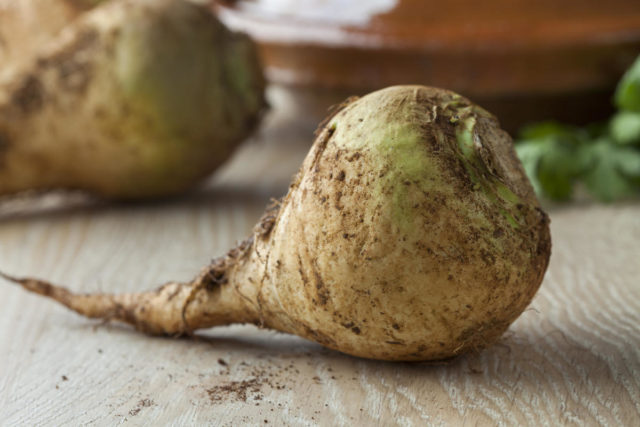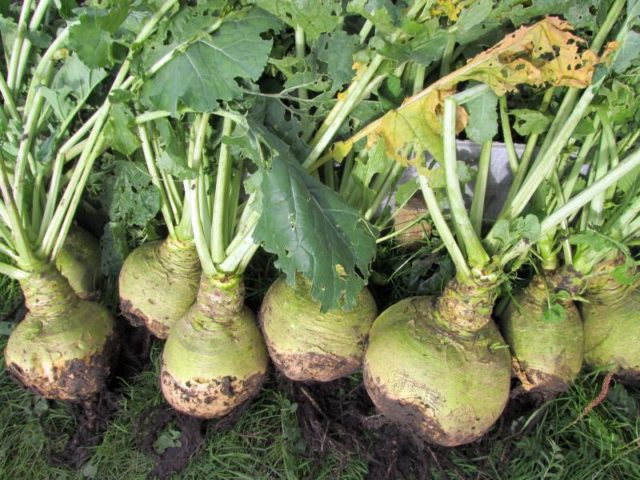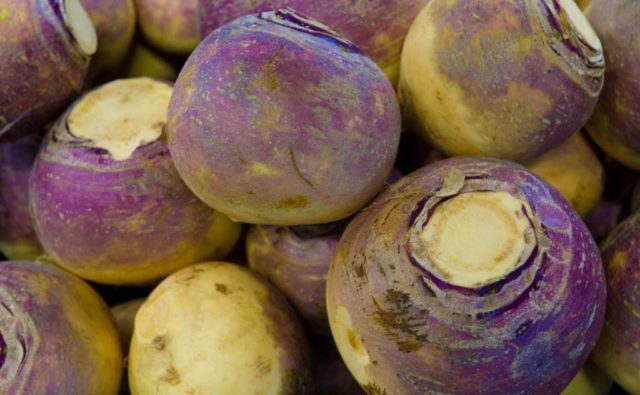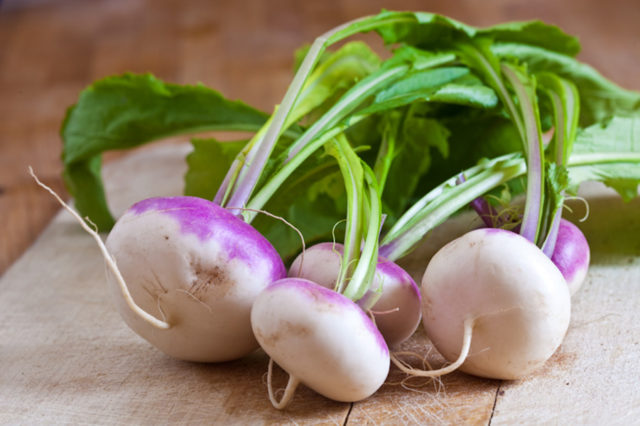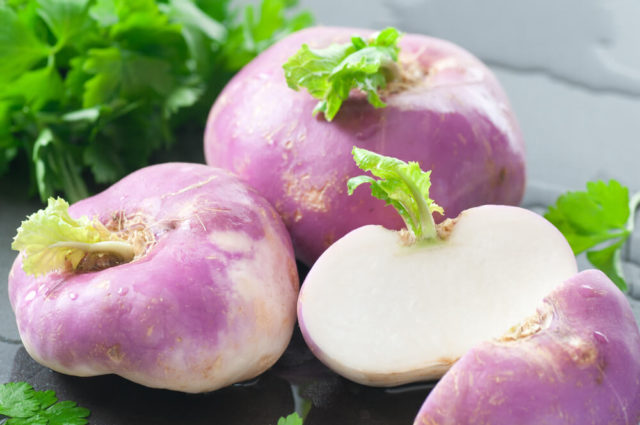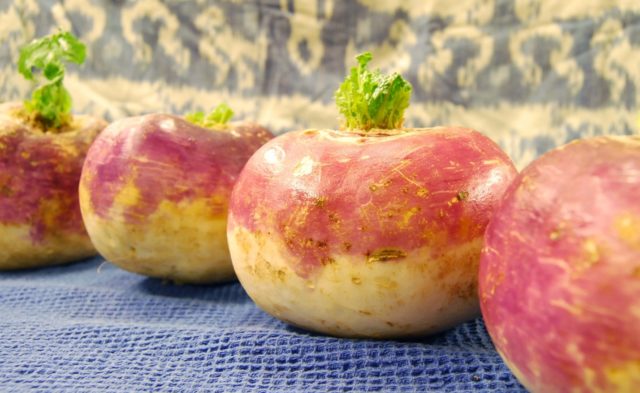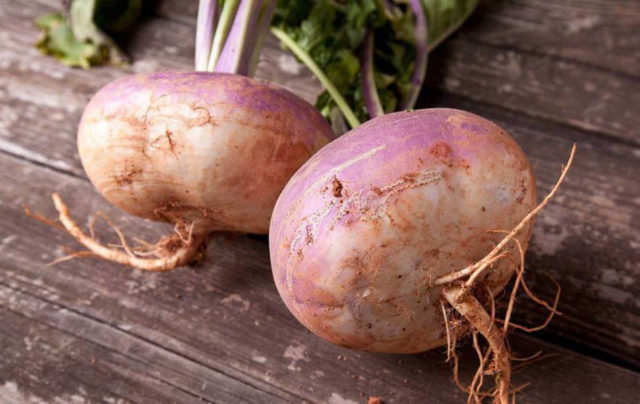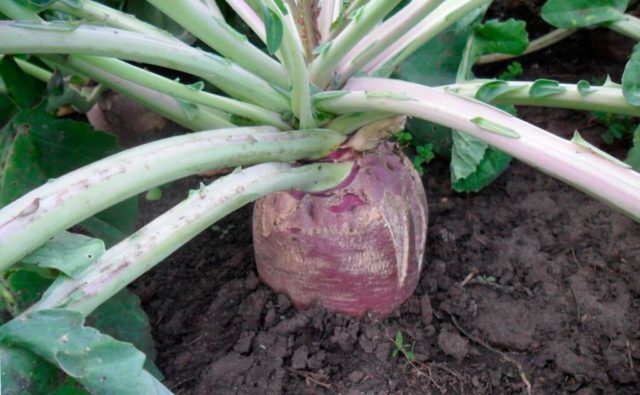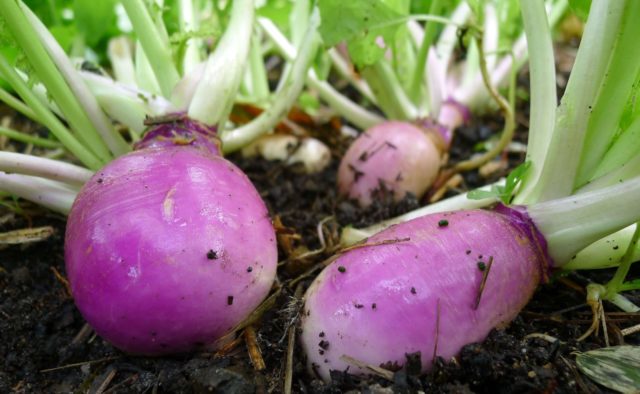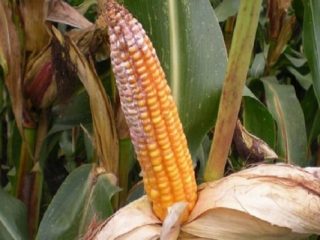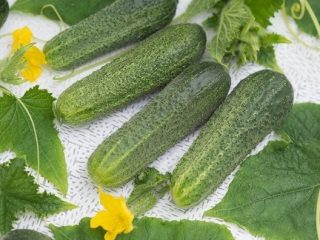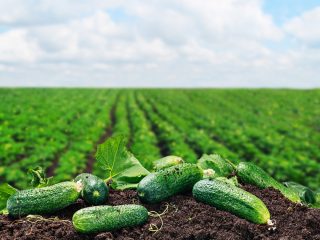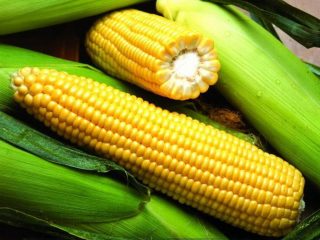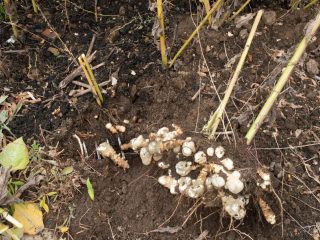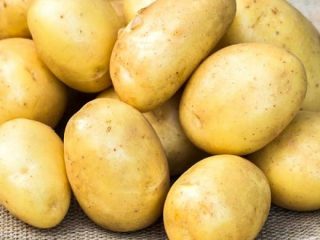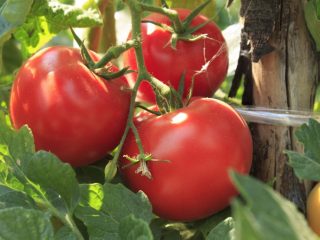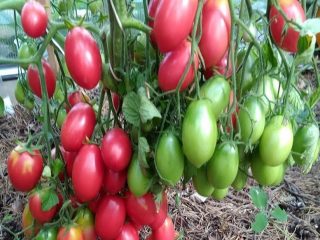Content
In terms of nutritional and medicinal qualities, rutabaga is similar to turnips, but surpasses it in the amount of mineral salts and carbohydrates. And the amount of vitamin C in it remains unchanged throughout the winter. Growing and caring for rutabaga in open ground is not difficult for any gardener, even a beginner. It is necessary to follow the usual rules of agricultural cultivation, and rutabaga will delight you with its tasty and healthy fruits throughout the year.
Origin of rutabaga
Rutabaga (Brassica napobrassica – lat.) is a type of fruit and vegetable crop of the Cabbage genus of the Cruciferous family. The vegetable is a natural hybrid that appeared as a result of natural crossing of turnips with cabbage. The first scientific description of rutabaga was made in 1620 by the Swiss botanist-taxonomist Caspar Baugin, who noted that it grows wild in Sweden, where it remains popular among the local population to this day.
There is another theory of origin, according to which Siberia is considered the birthplace of rutabaga. Before Peter I imported potatoes into the country, they were one of the most consumed vegetables. It was from there that rutabaga was brought to Scandinavia and spread throughout Europe. Proponents of this theory cite the vegetable’s excellent resistance to low temperatures as the main argument.
There are yellow-meat varieties of rutabaga - this is a table vegetable grown by humans for food. And white meat ones are used as livestock feed. Universal varieties have also been developed for both purposes.
Where are rutabaga grown?
In the Middle Ages, rutabaga was common in the Mediterranean, Scandinavian countries, and France. Currently, it is widely grown in Europe: Germany, Sweden, Spain, Finland. In England there is a national dish made from rutabaga with meat. Rutabaga is grown in Canada, Australia, and New Zealand.
Recently, interest in planting rutabaga in Russia has increased. It is most grown in the middle zone and northwestern part of the country. Using the seedling method, rutabaga is cultivated in open ground and in more northern regions of the country, where summers are very short. But in the south, due to the lack of water that the vegetable needs, rutabaga has not found wide distribution.
The best varieties of rutabaga
Rutabaga varieties with photos and descriptions help you understand that they differ from each other in root size, resistance to growing and care conditions, ripening time, purpose and yield. There are few domestic varieties of rutabaga. Only 6 of them are included in the State Register of Russia. All these types of rutabaga have passed the appropriate test and are allowed to be planted in open ground in all regions of the country.And moreover, these are the best varieties of rutabaga both for the middle zone and for any region of Russia, thanks to the unpretentiousness of the crop to environmental conditions.
Rutabaga Krasnoselskaya - a mid-season vegetable, the harvest of which can be harvested 110-120 days after the appearance of the first shoots. The root vegetable has an elongated, round shape, greenish color with a purple tint and juicy, sugary pulp. Its weight ranges from 300 to 600 g. This variety of rutabaga is well stored all year round.
Rutabaga variety Bright Dream – early ripening, produces a harvest after 65-70 days. Root vegetables have an elongated shape with a yellow peel and juicy tasty pulp. The fruits are small, reaching a weight of 300-350 g.
Variety Novgorodskaya – the fruit has juicy, tender beige flesh. Root vegetables with a purple color on top and a light bottom, rounded-elongated shape, can grow up to 400 g, winter well, retaining their taste. The fruits are mid-ripening.
Child love – a variety whose technical maturity occurs 90-110 days after planting in open ground. Root crops are round in shape with a faint brown-green color and with proper care reach a weight of 350 g. The inner part has a yellowish tint, is juicy with a pleasant taste.
Rutabaga Hera – a mid-ripening variety, the fruits of which reach removable ripeness within 3 months from the moment full sprouts appear. Root vegetables with anthocyanin-colored skins have a delicate taste and grow up to 300-400 g in weight.
Verean rutabaga – produces mature fruits 3 months after planting in open ground, therefore it is considered a mid-season vegetable. The roots have a flat-round shape with a red-violet skin. The fruits are relatively small, reaching a weight of 250-300 g.
The following types are also considered popular varieties of rutabaga for growing in the Moscow region among gardeners.
Rutabaga Swedish - an unpretentious variety with a yellow or red tint of pulp, inferior in taste to Krasnoselskaya rutabaga. It has large root crops weighing up to 1 kg, produces good yields and retains its quality all winter.
Kohalik – a mid-ripening, productive variety with fruits that have yellow, juicy pulp and are pleasant to the taste. Root crops have a light purple color on the upper part and a light purple color on the underground part. Reach a mass of 1 kg. Grown as a table vegetable.
Late variety Kuzma – a high-yielding variety with a mass of round and cone-shaped fruits up to 1.5 kg. The growing season from the moment of planting is 4-5 months. Resistant to fungal diseases.
Variety Marian – universal, suitable for human consumption and livestock feed. Produces high yields of fruits weighing up to 600 g. The vegetable does not require special care, is immune to temperature changes and is resistant to fungal diseases.
The variety should be selected according to its purpose, qualities and desired result. Each of the above types has a pleasant taste and is very easy to care for. Therefore, gardeners who took the risk of planting rutabaga in their open ground are satisfied with the results obtained.
How to sow rutabaga for seedlings
Vegetables are grown in different ways - by sowing seeds directly into the garden bed and planting seedlings. The second method is most common in the northern and middle regions of Russia, since the growing season for rutabaga is quite long and a short summer may not be enough for it.
When to plant rutabaga seedlings
If desired, you can sow in 2-3 terms. The timing of the first planting of rutabaga seeds for seedlings should be calculated so that with proper care, planting in open ground will be done in 40 days, and the first harvest will be ready for harvest in mid-summer. The last planting should be carried out so that the root crops ripened in the fall do not freeze with the onset of cold weather and retain their taste. In central Russia, the time for the first sowing begins in April.
Preparing the soil and container
To plant rutabaga seedlings, choose deep wooden or plastic boxes, possibly pots, so that the plant can take root freely. The container is filled with the nutrient mixture so that there is a distance of 2 fingers width left to the top. The mixture can be obtained by taking garden soil and adding mineral fertilizers to it, or you can buy it in a store. Some gardeners recommend adding wood ash to the mixture - 1 tbsp. l. per 1 kg. It protects seedlings from diseases and serves as a good source of microelements for the plant.
Seed preparation
The choice of seeds must be approached responsibly and prepared correctly. The seeds are first disinfected in a garlic or manganese solution, placing them in it for an hour. Then washed in clean water and dried. Next, you should germinate them by placing them in a damp cloth for several days. When white sprouts appear, you can plant the seeds in the prepared soil mixture for seedlings.
Sowing seeds
Seeds are sown for seedlings approximately 1.5 months before planting the seedlings in open ground. Seeds are immersed in the soil to a depth of 1.0-1.5 cm every 2-3 cm.Before planting, you can mix the seeds with superphosphate and scatter them evenly into boxes with a moist substrate. Sprinkle the soil mixture on top and water well.
Seedling care
The sown seeds are covered with glass or film and kept at a temperature of about +180C. When the first shoots appear, the film is removed and the boxes are transferred to a room with a temperature of 6-70C. When several days have passed after planting, the temperature is increased to 12-130C. In this way, seedlings are hardened. All the time while it is growing, care consists of watering, loosening, and, if necessary, thinning.
How to plant rutabaga in open ground
Planting can be done with pre-prepared seedlings or directly with seeds. Site selection and soil preparation play a big role in the further growth of rutabaga. The best harvest is obtained on moist loamy soil with moderate sunlight. The most suitable temperature regime is +16…+180C. As temperatures rise, it is important to ensure timely watering.
Planting rutabaga in open ground with seedlings
About 2 weeks before planting the seedlings in the garden, they begin to harden them. To do this, the boxes with seedlings are taken outside for a while. When the sprouts are ready to remain quietly outside for 24 hours, they are planted in open ground.
Rutabaga does not require any special soil requirements. It is better if the land is fertile - sandy loam, loamy or fertilized with peat compost. It is advisable to prepare the site in the fall: dig it up, adding manure, potassium salt, urea and superphosphate.
Planting seedlings in open ground is carried out if the seedlings have 4-5 strong leaves. They do this as follows:
- Prepare holes at a distance of 15-18 cm between them in one row, placing the rows half a meter apart from each other.
- Spray the holes generously with water.
- The seedlings are dipped in a clay mash, placed in a hole and dug in so that there is no bare stem left, and at the same time the root collar is not deep underground.
- Lightly compact the soil around the seedling.
- Wet the soil again from the watering can.
Growing rutabaga in open ground from seeds
You can also plant rutabaga from seeds directly into open ground. The beds need to be prepared in advance. Seeds are sown in rows to a depth of 2.5 cm. When the first shoots appear, thinning is done, leaving 4 cm between shoots. After 4-5 strong leaves sprout, a second thinning is done so that 15-20 cm remains between plantings.
There is another way to grow from seeds in open ground - winter planting. Sowing is carried out in late autumn, when the ground begins to freeze. The area is dug up in advance, fertilizer is applied, holes are made, sand is poured into the bottom, 2 rutabaga seeds are placed, sprinkled with sand and humus so that the seeds are at a depth of 2.5 cm.
How to grow rutabaga in open ground
Growing rutabaga is not difficult. As a rule, it produces good yields in any open ground and in any weather. Rutabaga does not like acidic soils, which can be neutralized.When planting, you should take into account the rules of crop rotation.
The best soil for rutabaga is considered to be the soil on which legumes, nightshade, and pumpkin crops grew before it. You should not plant rutabaga in areas where relatives of this crop grew: turnips, radishes, cabbage.
In order to grow a decent harvest, planting and caring for rutabaga in the open ground must be carried out following a standard set of agrotechnical rules for growing fruits and vegetables, namely:
- timely watering;
- applying the necessary fertilizers;
- weeding and loosening the soil;
- measures to protect against diseases and pests.
All this is familiar to any gardener and does not present any difficulties.
Watering and fertilizing
Rutabaga is a moisture-loving plant. If there is not enough water, the root crop will grow tough and taste bitter. Too much water will make it watery and tasteless. Therefore, rutabaga is watered 3-5 times from the moment of planting in open ground, taking into account weather conditions.
When watering, it is advisable to use a nozzle so that a strong stream of water does not expose the root, which will turn green and lose its quality. One bucket of water per 1 square meter is enough. m plot.
Fertilizer fertilization is carried out twice after planting on the bed:
- After two weeks, the sprouts are watered with slurry.
- At the beginning of the formation of the root crop, fertilizing is done with mineral fertilizers.
Loosening and hilling
An obligatory point in the technology of cultivating rutabaga is loosening the soil, hilling the bushes and weeding. The first time loosening is carried out immediately after planting the seedlings.
These actions enrich the soil layer with oxygen, improve the heating of the soil by the sun, stimulate plant growth, and help fight weeds and insect pests. In total, about 5-6 loosenings are done per season immediately after watering.
Protection from diseases and pests
Rutabaga is a relative of turnips, radishes and all types of cabbage. Therefore, the diseases and pests to which these crops are susceptible are the same.
The most common diseases are:
- blackleg;
- felt disease;
- mosaic.
From pests:
- cruciferous flea beetle;
- bedbugs;
- aphid;
- spring cabbage fly;
- sprout fly;
- slugs
After planting the seedlings in the beds, to prevent the attack of the cruciferous flea beetle, the plants are pollinated with wood ash or sprinkled with fine lime. The use of insecticides and fungicides is standard.
To reduce the possibility of rutabaga being affected by diseases and pests, some agrotechnical care measures should be taken:
- follow the rules of planting and crop rotation, do not plant rutabaga in an area where related crops previously grew;
- treat seeds before sowing to prevent the occurrence of disease;
- regularly remove weeds that weaken vegetable plantings;
- in the fall, after harvesting, remove all plant debris from the site so that it does not become a wintering ground for pests;
- dig up the soil for the winter, destroying the laid eggs of insects and their larvae.
Rutabaga yield
The main conditions for obtaining a good rutabaga harvest are the presence of moist soil and the absence of drought.The vegetable also responds gratefully to fertilizing with organic fertilizers after planting in open ground.
Harvesting can be done when the root crops have reached a diameter of 5-6 cm. It is not recommended to overgrow rutabaga, as the pulp will lose its tenderness. Different varieties can produce different yields:
- Krasnoselskaya - from 4.4 to 5.2 kg/m2;
- Bright dream - from 2.5 to 3.5 kg/m2;
- Novgorodskaya - 4-4.5 kg/m2;
- Children's love – 5.8-6.2 kg/m2;
- Hera – 4.5 kg per m2;
- Vereskaya - 3.5-4.0 kg per 1 m2.
Under favorable conditions in central Russia, you can remove up to 8 kg of vegetables from 1 m2 land.
Storing rutabaga for the winter
To store rutabaga root crops for the winter, they begin to dig up in early September and finish before the onset of the first frost. The fruits are carefully dug up so as not to damage them, and dried well in a ventilated place. Cracked and damaged fruits are separated. They are not suitable for storage; they are best consumed immediately.
Rutabaga can be safely stored for several months without losing its nutritional and taste qualities at temperatures from 0 to +40C, placed in boxes and covered with sand. It can be laid out on shelves in an unheated room (basement, cellar) or placed in dug earthen trenches, sprinkled with sawdust and dry grass, and sprinkled with earth on top.
Recently, gardeners have been storing rutabaga in plastic bags and consider this method successful. Under such conditions, the concentration of carbon dioxide and humidity required for storage increase.
Conclusion
Since rutabaga is not widely popular among gardeners, it may seem that growing and caring for rutabaga in the open ground is something special. Actually this is not true.The same agrotechnical rules for planting and a little attention to care are used for related crops: cabbage, turnips, turnips. And the vegetable can be consumed fresh or stewed in various dishes all year round.
